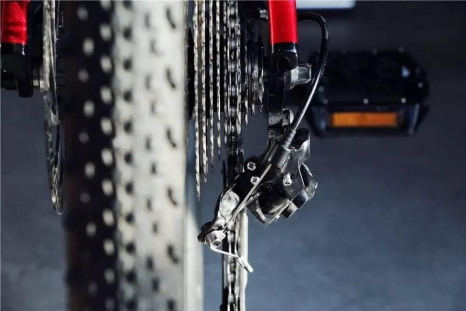Generally, screws are marked with “H” and “L” beside them. H stands for high-speed tooth screw, L stands for low-speed tooth screw. By the way, a rule applies to most speed adjustments: adjust the upper and lower limits of the rear derailleur and turn the screws clockwise to make the upper and lower limits move toward the center.

Drop the chain:
Chain drop is one of the most common problems encountered in riding. If your chain frequently drops, it means that there is a problem with the cooperation between the transmission and the flywheel. The guide wheel and the flywheel are not in the same plane, and the chain is led out of the flywheel.

The guide wheel should be in the same vertical plane as the gear of the corresponding gear.
The chain falls out of the smallest sprocket of the flywheel:
Observe whether the guide wheel and the smallest sprocket of the flywheel are in the same vertical plane. Generally, the chain is dropped when the guide wheel is too far out. At this time, we need to adjust the guide wheel back: turn the screw of the high-speed gear clockwise to adjust the lower limit of the guide wheel.

The chain falls out of the largest sprocket of the flywheel:
It is also necessary to observe whether the guide wheel and the smallest sprocket of the flywheel are in the same vertical plane. Too far out of the guide wheel will cause this kind of chain drop. At this time, we need to adjust the guide wheel so that it is parallel to the largest tooth of the flywheel: the screw at the low-speed gear position, turn it clockwise, to adjust the upper limit of the guide wheel back.

Abnormal sound of rear derailleur:
Usually, it is caused by the distance between the guide wheel and the flywheel too close. At this time, we have to adjust the tension of the rear derailleur. Turn the screw clockwise to loosen the rear derailleur, and the distance from the flywheel will become farther. We need to adjust the distance between the guide wheel and the gear of the flywheel to 5~10mm to solve the abnormal sound.

PS: Because this adjusting screw can adjust the tension of the speed change, it can also fine-tune the accuracy of the speed change to a certain extent. If your speed change is not accurate (because the tension of the speed change cable is not appropriate), you can also fine-tune this screw to fine-tune the tension of the speed change. effect.
Can not go from low to high or high to low:
If the second gear is raised to the third gear the chain shakes and the gear cannot be shifted smoothly, turn the fine-tuning screw at the end of the transmission cable a small amount counterclockwise to tighten the transmission cable until it reaches the third gear smoothly. If the chain jitters and shifts slowly when the 3rd gear is lowered to the 2nd gear,
turn the fine-tuning screw at the end of the shift cable a small amount of clockwise to loosen the shift cable until it smoothly drops to the second chainring.


